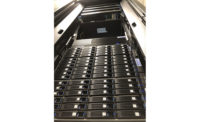The demand for video surveillance, combined with continued advancements in technology and resolution, is driving most of the demand for video storage solutions. Video analytics, 360-deg. cameras and organizations’ use of video for a wider variety of purposes beyond security are some of the trends that are increasing the need for longer video retention requirements and have led to end users’ growing need for more storage capacity.
The resulting increase in data generation and the growing importance of video has led to a technology shift from closed, proprietary systems to mission-critical applications that are often hosted within data centers and/or managed by IT departments. This evolution is significant, says Brandon Reich, senior director of surveillance solutions, Pivot3, Austin, Texas, because IT departments tend to turn to traditional technologies for video and data storage infrastructure. However, this is far from an ideal solution.
“Traditional infrastructure, such as standard servers or SAN storage, is not well suited for video surveillance environments and can lead to problems that may result in system downtime or data loss,” Reich says.
Therefore, when it comes to video storage solutions, end users are looking for a number of things. First and foremost is reliability.
Modern organizations can no longer tolerate system downtime and data loss, so live and recorded video must be available and accessible even when hardware fails. — Brandon Reich,
Pivot3
“Storage systems must continuously capture large amounts of video without dropping frames, which leads to image quality degradation,” Reich says. “Modern organizations can no longer tolerate system downtime and data loss, so live and recorded video must be available and accessible even when hardware fails.”
Because organizations rarely, if ever, remain static, their needs are likely to grow and/or evolve over time, making scalability another major consideration for storage.
“End users’ video needs constantly change, so the storage systems must allow them to start small and grow as needs and budgets change over time,” Reich says.
These important factors often come at a price, and while that may have made video storage a difficult sell in the past, that mindset has shifted in recent years.
“Over the past decade, end users have moved away from the cheapest solution,” says Tom Larson, director of engineering, BCDVideo, Northbrook, Ill. “The market has learned that these solutions come with less reliability, compromised performance, and poor warranty protection. End users are now willing to pay for quality.”
FOR YOUR CONSIDERATION
Keeping in mind those factors that are most important for end users, there are several features and specs that security integrators should consider when selecting the most appropriate storage solution for meeting the specific needs of their customers.
“First, has the solution been tested and certified with the VMS being used on the project?” Larson says. “Also consider the warranty; an enterprise job needs an on-site warranty because uptime is everything.”
A third consideration Larson offers is the quality of the hard drives used in the storage array.
“An enterprise job requires the storage array to be built with enterprise SATA or SAS drives,” he says. “So many products on the market state they are for enterprise video projects but are built out of consumer PC-grade hard drives.”
These traditional storage solutions are more vulnerable to downtime and data loss. According to Reich, hard drives are three times more likely to fail in video surveillance than other “normal” applications. Developed in the 1970s, RAID, which is commonly used in consumer-grade drives, can only protect data against one or two drives failing simultaneously. The result of additional failures is permanent data loss, which is hardly acceptable in security applications. And regardless of the number of drives that may fail, recovery is not a quick process.
“Rebuilding failed drives with RAID can take days or weeks to complete, drastically slowing system performance and making them vulnerable to permanent data loss if additional drives fail during the rebuild,” Reich says.
Therefore, reliability is especially critical because a wide variety of organizations — from law enforcement and casinos to schools and enterprise businesses — have never been hungrier for data and surveillance as part of their intelligence-building strategy, Reich says. The information gleaned from video has multiple benefits for organizations, including identifying potential security events, ensuring compliance with regulations, determining the success of marketing campaigns, monitoring operations at remote sites and more.
“All of these use cases demonstrate the benefit of using video surveillance as a security and business optimization tool,” Reich says. “But as the value of video increases for customers, you have to ensure the investment is protected.”
To ensure the greatest reliability, Reich says integrators should consider specifying more advanced IT solutions than those traditionally relied on to store video. In particular, he points to hyper-converged infrastructure (HCI) as a good solution. (For more on HCI, see “On the Horizon” on page 138.)
“Opportunity is ripe for systems integrators that can deliver the hardware, services and expertise of solutions that look to the future, and help users redefine the security operations center,” he says.
In addition to these factors, Jessica Burton, global product marketing manager, Seagate Technology, Cupertino, Calif., suggests security integrators look for solutions that offer support for up to 64 HD cameras to enable recording of multiple data streams simultaneously, and enhanced vibration capability for drives deployed in harsh edge environments.
What Integrators Want
Without a doubt, storage providers are mindful of delivering solutions that meet the needs of end users through ongoing development. But what are security integrators looking for in storage solutions?
After posing that question to four people within his company (two salespeople and two technicians), Jeremy Bates, president of Lexington, Ky.-based Bates Security, provided the following perspective:
Network Capability
In some ways, retrieving and/or exporting information remotely seems to be a more difficult or time-intensive process than customers would like. This is often the result of low bandwidth on-site and/or at the remote location. As Internet speeds get faster and more affordable, the hope is that this will decrease.
Contributing to this challenge is end users’ general lack of understanding about how much data they are saving, the length of time they are saving it, and how those factors impact wait times for accessing video footage. Often a technician will start the process of saving footage, knowing how long this will take because of technology limitations. In the meantime, the technician will work on other things before returning to that task, which can be frustrating to end users who expect everything to work immediately.
Edge Storage
Cameras that record at the edge are great, but it would be even better if manufacturers could create a notification that would alert someone if that isn’t working. We’ve had issues with certain cameras not recording on the SD cards and not knowing about it until we showed up to retrieve footage for the customer. A software solution that would send an email alert if the SD edge recording was not functioning would allow us to rectify the situation long before there was an issue with lost video.
On the Horizon
Like every facet of the security industry, new technologies are constantly shifting the storage market, bringing additional features and functionalities, as well as lower costs that allow end users to get more bang for their video surveillance buck. Below are the four main technology advances storage providers identified as having the greatest impact for security integrators.
Capacity
For all the talk of cloud storage, BCDVideo’s Tom Larson says the importance of local servers doesn’t show any signs of diminishing any time soon.
“On-premises storage will always be vital to maintaining a more reliable solution for sensitive video data when compared to cloud-based storage,” he says. “The advantages of reliable on-premises storage include no monthly storage fees, no additional cost to view the video, and no mandatory software upgrades.”
Because of this, the new 10-terabyte hard drives currently hitting the market are likely to have the greatest impact on the space, particularly when it comes to driving down overall storage costs.
“These drives allow you to get more storage into the server chassis,” Larson says. “With the introduction of 10-terabyte hard drives, security integrators will provide end users with the ability to securely and reliably access their video data on-site while maximizing the scalability of a single server.”
HCI
A relatively new concept in video storage is hyper-converged infrastructure (HCI), which eliminates complexity and cost while delivering enterprise-class benefits at a more affordable price point, says Pivot3’s Brandon Reich.
“HCI is a common IT solution that is growing in demand in surveillance environments because of the significant limitations of DAS-based platforms, such as NVRs and DVRs,” he says.
At its most basic level, HCI uses software to combine sophisticated — and expensive — data storage and server hardware into a simple appliance-based solution. Leveraging software-defined storage and server virtualization, HCI can be deployed on industry-standard off-the-shelf server hardware to increase scalability, reduce complexity and eliminate the need for teams with advanced IT skills. This makes HCI well-suited for a wide variety of applications, Reich says.
“HCI solutions can be specialized to meet the unique needs of video surveillance, offering far more functionality and performance than traditional IT infrastructure,” he says. “As more organizations look to adopt advanced technologies, such as panoramic cameras, video analytics and PSIM, more traditional IT storage solutions will be challenged by the write-intensive nature of surveillance.”
Size
Technology advancements will also include a push toward hard drives that are more mobile and come in smaller form factors to meet everyday demands of fleet management and edge environments, for example, says Jessica Burton of Seagate Technology.
“For systems integrators, this will broaden their customer reach and opportunities into a growing market that has just begun to develop and evolve for fleet management, smart cities and smart car environments,” she says.
Connection and Configuration
The way storage solutions connect to video surveillance systems is another area where the market is beginning to see changes, including the use of Thunderbolt ports, says Erick Oliveros, marketing manager, QNAP, Pomona, Calif. Developed by Intel and Apple, Thunderbolt technology combines PCI Express and DisplayPoint technologies into a single connection, allowing a mix of up to six peripherals, such as storage, monitors and others, to be daisy-chained together.
Direct-attached features are also coming to market, making it easier than ever for residential and SMB customers to initialize and configure network-attached storage (NAS) solutions. This is a particularly significant development in the growing Internet of Things (IoT) world, Oliveros says.
“Users no longer have to have their NAS connected to the network to initialize it; they can just plug their laptops or Macs into their NAS to set it up,” he says. “They can also drag-and-drop their data directly onto their NAS as well.”
Off-the-Shelf?
While all customers want to deploy solutions that increase their security, the reality is that cost often plays a large factor in the final decision of which devices and software are actually deployed. In many cases, professional-grade, surveillance-specific storage solutions are simply out of reach for the average end users. As a result, far too many opt for consumer-grade, off-the-shelf models to save costs, not understanding the risks associated with that choice, the first of which is reliability.
“Reliability is the biggest concern,” says Tom Larson of BCDVideo. “Consumer products have made their way into the market due to the pressure integrators face to cut costs. This trend has been happening over the past few years. The professional products are more expensive. So, the pressure storage manufacturers and integrators face to reduce costs has led to the acceptance of cheaper, less reliable storage; however, the consumer-grade products fail prematurely, and the end user suffers by not having video available.”
So just how prevalent is this trend?
“That really depends on the user’s budget and tech savvy,” says Erick Oliveros of QNAP. “There are great off-the-shelf solutions that suit certain customers’ needs. But if customers are looking for options like long-range storage, large-scale camera compatibility, robust detection features and customizable interface features, then that’s where solutions like ours come into play. But for the most part, we have solutions for any budget and any need, large or small.”
The market for these off-the-shelf solutions is relatively narrow, says Brandon Reich of Pivot3.
“We typically see consumer-grade storage in the small-to-medium business segment or within environments that don’t view video as being mission critical. But as you can imagine, there are fewer and fewer businesses that don’t see video as being an important data set,” he says. “Consumer-grade storage is not designed to handle streaming video data from modern high definition cameras, and is highly prone to poor performance and hardware failures that can lead to permanent data loss.”
Thankfully, Reich adds, advanced storage solutions are becoming more and more cost-effective, which will help reverse the trend toward consumer-grade storage for surveillance applications.
“Today, small-to-medium sized enterprises can realize the benefits of highly efficient shared storage and built-in failover without the complexity or cost typically associated with infrastructure based on separate servers and SAN storage,” he says. “These high-performance systems can support up to 200 surveillance cameras and are available at a price point competitive with direct attached storage (DAS) typically deployed in mid-sized NVR applications. This type of storage allows SMBs to protect their investment, even during hardware failures, a feature typically only found in enterprise IT environments.”
MORE ONLINE
For more on video storage visit SDM’s website, where you’ll find the following articles:
“5 Questions Integrators Should Ask about Video Storage”
www.SDMmag.com/questions-integrators-should-ask-about-video-storage
“Surveillance Video Storage”
www.SDMmag.com/surveillance-video-storage
“Managing Video Storage / Compression Formats”
www.SDMmag.com/managing-video-storage-compression-formats












